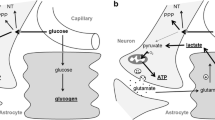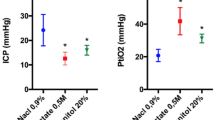Abstract
Increased extracellular glutamate levels are related to glial and neuronal damage. Glutamate-mediated toxicity is limited by glial uptake and metabolic transformation of glutamate to glutamine and the energetic compounds alanine and lactate which are utilized by surrounding neurons. Under in vitro conditions, barbiturates have been shown to reduce glutamate uptake and its further metabolism, possibly impeding metabolic coupling between astrocytes and neurons. The aims were to investigate if under clinical conditions, the barbiturate thiopental reduces important detoxification of glutamate, resulting in lower CSF glutamine, alanine and lactate levels as opposed to patients receiving midazolam. During long-term administration of thiopental and midazolam, pathologically elevated ventricular CSF glutamate levels were associated with significantly increased glutamine and alanine levels up to 14 days after trauma. CSF lactate, however, remained normal. These data suggest that long-term administration of thiopental and midazolam under clinical conditions does not impede enzymatic activities responsible for detoxification and metabolism of glutamate.
Similar content being viewed by others
Author information
Authors and Affiliations
Additional information
Received: 10 March 1998/Final version: 25 May 1998
Rights and permissions
About this article
Cite this article
Stover, J., Pleines, U., Morganti-Kossmann, M. et al. Thiopental and midazolam do not seem to impede metabolism of glutamate in brain-injured patients. Psychopharmacology 141, 66–70 (1999). https://doi.org/10.1007/s002130050807
Issue Date:
DOI: https://doi.org/10.1007/s002130050807




